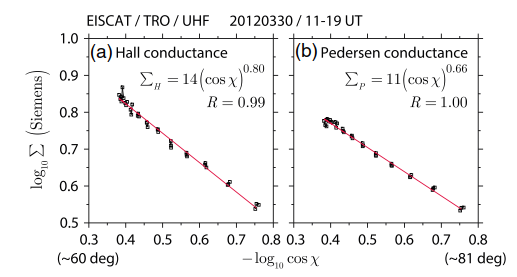Approximate forms of daytime ionospheric conductance (Ieda et al., JGR, 2015)2017.2.18
The solar zenith angle (SZA) dependence of the conductance is studied and a simple theoretical form for the Hall-to-Pedersen conductance ratio is developed, using the peak plasma production height. The European Incoherent Scatter (EISCAT) radar observations at Tromsø (67 MLAT) on 30 March 2012 were used to calculate the conductance. The daytime electric conductance is associated with plasma created by solar extreme ultraviolet radiation incident on the neutral atmosphere of the Earth. However, it has been uncertain whether previous conductance models are consistent with the ideal Chapman theory for such plasma productions. We found that the SZA dependence of the conductance is consistent with the Chapman theory after simple modifications. The Pedersen conductance can be understood by approximating the plasma density height profile as being flat in the topside E region and by taking into account the upward gradient of atmospheric temperature. An additional consideration is necessary for the Hall conductance, which decreases with increasing SZA more rapidly than the Pedersen conductance. This rapid decrease is presumably caused by a thinning of the Hall conductivity layer from noon toward nighttime. We expressed this thinning in terms of the peak production height in the Chapman theory.
カテゴリ:Currents,Ionosphere

